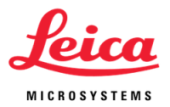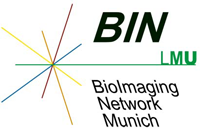Stellaris: Inverted confocal with fluorescence lifetime
This confocal microscope is made available to the Core Facility Bioimaging thanks to an agreement with Leica Microsystems.
Advantages
Advantages of this 2023 model compared to our other confocals are:
- Excitation at 405 and continously from 440 up to 790 nm. Thus optimal excitation of CFP and far far red fluorochromes.
- Detection up to 850 nm and higher sensitivity in the far red range (HyD R detector) and in the blue and green range from 410 to 550 nm thanks to a silicone detector (HyD S). This allows for additional spectral channels, thus more fluorochromes.
- Higher robustness of HyD S compared to other HyDs, thus no PMTs needed any more.
- Fluorescence lifetime tools for standard confocal usage for additional contrast (TauContrast), removal of unwanted signal (TauGating), lifetime-based species separation (TauSeparation) or FLIM-FRET (TauInteraction).
- In addition, full FALCON module for fluorescence lifetime imaging (FLIM).
- Rolling average display of live images provides higher signal-to-noise images in live cell imaging (Dynamic Signal Enhancement, DSE).
- Integration of AI tools to increase signal-to-noise at high acquisition speed with less motion blurring (AIVIAMotion).
- Confocal super-resolution and improved signal to noise ratio for any confocal experiment with fully integrated computational clearing (Lightning).
Description
Optics
Objectives
The following objectives are available with the system. In addtion, objectives from our other microscopes are compatible and can be used if needed.
HC PL APO 20x/0.75 IMM CORR CS2 (15506343)
HC FLUOTAR L 25x/0.95 W VISIR 0.17 (15506375)
HC PL APO 63x/1.20 W motCORR CS2 (15506361)
HC PL APO 63x/1.40 OIL CS2 (15506350
HC PL APO 63x/1.30 GLYC CORR CS2 (15506353)
DIC Prisms
IC Prisms C, D and E and the respective condenser prisms are available. If "DIC" is selected in the software, the correct configuration will be loaded automatically. Note that a DIC prism in the beam path has a negative impact on your confocal (fluorescence) resolution!
Confocal Light Path
Excitation Lasers
- 405 nm laser for excitation of Dapi and related dyes.
- White Light Laser (WLL) with continous output from 440 to 850 nm.
Detectors
HyD S (S for silicone) are the new standard detecors. They replace the PMTs used in SP8 and older models. HyD X are comparable to the HyDs in the SP8. HyD R has a different coating that shifts sensitivity towards the red end of the spectrum. For more information see Leica's Science Lab page here. All detectors do photon counting. The postions in the scan head are filled as follows:
- HyD S
- HyD X
- HyD S
- HyD X
- HyD R
Fluorescence Lifetime Imaging (FLIM)
The Stellaris 8 has certain lifetime tools already in its default configuration. This particular model, however, also comes with the full FALCON (FAst Lifetime CONtrast) module that some of our users already know from Gaviola or Kellner. The White Light Laser is pulsed, so that FLIM excitation is possible from 440 to 790 nm. All five detectors can be used for FLIM.







